China’s War on Pollution: Spotlight on Water

60% of China's groundwater is unfit for human consumption. How are companies responding to this?
Setting the scene: China
Climate change is a global issue. As the case opens: “The risk of large-scale climate change is one of the central issues facing the world.” For this reason, I have chosen to focus my analysis on a non-US company, given that (1) the environment is an international responsibility; (2) I feel that my experience in Asia might add breadth to the scope of the section’s wider debate. I thus turn to China, and to “Beijing Enterprises Water”, one of the country’s key wastewater operators currently responding to China’s waste quality problems, a critical issue amid the wider “war on pollution” China is currently facing.[1]
In China, 60% of the groundwater is unfit for human consumption.[2] A 2014 government survey revealed that only 3.4% of the 968 monitoring sites met the highest “Grade I” standard (with 63% at grade III of VI or above). In addition, ~50% of the country’s major enviro-political unrest is water-related – making the issue not just about economics and health, but about political stability also. If we look at the exhibits below, it is easy to understand why:
Exhibit 1: Chinese water pollution – the sobering reality:
Left:A man swims in an algae-covered part of the Han River in Wuhan, Hubei province, 11 June 2014, Reuters, 2014; Right: A river in Wenzhou, Zhejiang Province, contaminated by unknown substances (thought to be blood), Reuters, 2014
Focusing on Beijing Enterprise Water:
As one of China’s leading water suppliers, BEW is an obvious company “in the firing line” to place our analysis. BEW originally began as a government sponsored water supplier, and overtime, gradually built a wide network of water supply and sewage plants around different provinces in China. However, with mounting pressure from the government and climate-change groups, BEW has pivoted its business focus to waste treatment.[4]
Exhibit 2: Chinese water pollution – the sobering reality:
Left:A boy swims in the algae-filled coastline of Qingdao, Shandong province July 15, 2011. Picture taken July 15, 2011. REUTERS/China Daily; Right: Worker Cleans Away Dead Fish At A Lake In Wuhan, Central China’s Hubei Province, Kyodo News 2015
In response to these spiralling problems, the government has been taking increasingly intense steps to tighten regulation, with efforts across wastewater, soil/air pollution, and CO2 emissions. Its focus on water pollution is likely to continue for at least the next ten years, owing to increasing scarcity from global warming, and demographic shift.
As the government has ramped up scrutiny of water standards, BEW has been forced to shift its focus from simply a supplier, to a wastewater treatment facility provider, investing heavily in water-environment technology and cleaning facilities, leading to improved efficiencies and utilization rate.
Exhibit 3: China has under-invested in environmental protection, but it has been catching up: Source: China Statistical Yearbook on the Environment, Wind
Exhibit 4: CO2 emission in the US and China: Air Pollution is a huge concern:
Left:Source: Energy Information Administration – EIA – Official Energy Statistics from the U.S. Government, July 2015; Right: A girl walks through smog in Beijing, where small-particle pollution is 40 times over international safety standard (3/43), Source: Kyodo News, 2015
Operational improvements and technological investment:
As mentioned, in response to the war on water pollution, the company has made technology and operational upgrades to existing capacity.
- The results of this provided them with the ability to add ~3.5mt/day of new wastewater treatment capacity in 2015/16, and gain more government projects due to their technology upgrades.
- With utilization further ramped up, analysts estimate that total annual wastewater processing volume will almost triple from 2,030mt in 2013 to 6,062mt in the full year of 2016, as shown in the company exhibits below:
Exhibit 5: Operational improvements in charts:
(a) Wastewater treatment and water supply capacity for BEWG in China (mt/day), sources: Company data, June 2016
(b) The utilization rate of BEWG’s wastewater treatment capacity has been rising, sources: Company data, June 2016
(c) Annual processing volume for wastewater treatment and water supply (mt), sources: Company data, June 2016
The result so far, and future steps:
BEW is now one of China’s leading water treatment and supply players, and has gained international recognition as a leading global water-treatment company.[5]
In order to further benefit I believe that BEW must continue to invest in its technology and treat more provinces. Specific to China, BEW must also maintain a positive relationship with the government. The company has been actively doing this by bidding for more “Public-Private-Partnerships (PPP)”, with a total investment of Rmb50bn. This should provide economies of scale, help improve operational abilities (a wider network is beneficial in a large country such as China), and lock in a larger number of long-term contracts.
Word count: 747
Footnotes:
[1] To place this in context, over the past few decades, in order to fuel tremendous economic growth, China has consumed an enormous amount of energy per unit of GDP. For example, in 2013, while contributing 15.4% of global output, China consumed 44%-61% of the world’s copper, coal, steel, aluminum and cement: the impact of this imbalance rendering China the world’s worst polluter. Studies have shown that out of the 161 Chinese cities closely monitored by the authorities, only 16 reached the national standards of urban air quality; while the amount of contaminated grains (by heavy metals) could feed 24million people. Sources: Chinese government studies released by the Chinese Ministry for the Environment, 2014; Goldman Sachs Investment Research, 2015
[2] Source: Survey carried out by the Chinese Ministry for the Environment, 2014
[3] Source: Photo series published in IBtimes referencing Reuters, “Dead Pigs and Rivers of Blood: Shocking Photos of Water Pollution in China”, http://www.ibtimes.co.uk/dead-pigs-rivers-blood-shocking-photos-water-pollution-china-1459222
[4] By the end of 31 December 2013, the Group had 130 sewage treatment plants and 4 reclaimed water plants in operation in Mainland China. The total daily design capacity in operation of sewage treatment plants and reclaimed water plants hit 6,259,750 tons (31 December 2012: 4,777,250 tons) and 418,000 tons (31 December 2012: 387,000 tons) respectively. The average daily processing volume hit 5,391,981 tons, with an average daily treatment rate of 81%. In addition, the company gained qualifications in engineering for consultancy and design of water treatment plants. As an integrated water system solution provider, the Group acquired extensive experience in bidding, building and operating sewage water treatment projects, and also successfully marketed its treatment technology and experience in construction services to other operators and constructors. Source: Company website
[5] At the 2014 Global Water Summit in Paris, held by “Global Water Intelligence”, Beijing Enterprises Water Group was selected in the top four in the “Water Company of the Year” category – the only company from China. The committee highly commended BEWG and recommended they continue to expand their portfolio both in China and overseas. Source: Company website


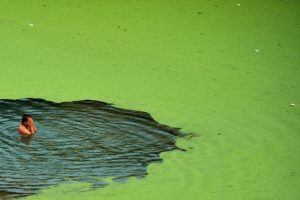




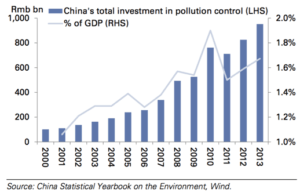
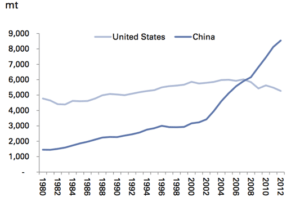
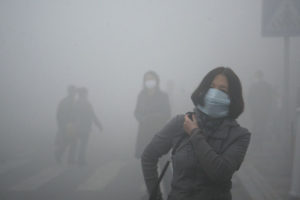

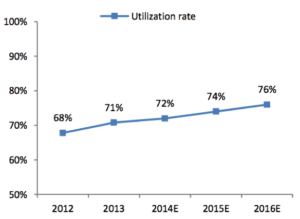
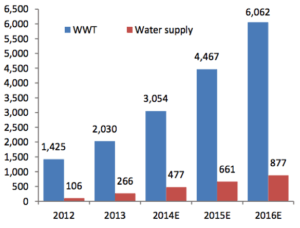
Thanks for sharing – very interesting post. I found it shocking to read that 60% of China’s groundwater is unfit for human consumption. I was aware of air pollution in the big cities, but didn’t know that groundwater pollution is such a significant issue. I also find it helpful that you included pictures to visualize the problem.
It is very encouraging to see that the Chinese government is taking increasing action against pollution, and BEW’s success so far looks highly promising. I fully agree with your recommendation that BEW and the Chinese government need to invest in its technology and treat more provinces. However, I wonder what the root causes are of groundwater pollution – is it related to climate change? If so, how? Or is it simply driven by lack of oversight over disposal of chemicals? Also, the effect of pollution in the big cities (as you showed in the picture of the smog) is clearly a very visible one. But will the Chinese government (and BEW) be as engaged with reducing the invisible greenhouse gases such as CO2 and CH4, which are the main contributors to global warming and climate change on a global scale? Let’s hope that governments keep to their promises of the Paris climate deal [1].
[1] The Guardian. 2016. Breakthrough as US and China agree to ratify Paris climate deal | Environment | The Guardian. [ONLINE] Available at: https://www.theguardian.com/environment/2016/sep/03/breakthrough-us-china-agree-ratify-paris-climate-change-deal. [Accessed 06 November 2016].
I love hearing about what governments, especially in developing countries, are doing about the most powerful environmental-economic concepts facing the world today… the tragedy of the commons. Your example is a great example of where private companies do not have to pay for their own externalities due to a lack of enforcement mechanisms, leading to resource loss and destruction of the environment.
I am glad that the Chinese government is starting to take such a hard stand against water pollution, however I do wonder if BEW is simply going to treat the symptoms rather than cure the main issue which is pollution by industry. BEW is obviously incentivized based on how much water they can treat, so they are actually incentivized to NOT have industry reduce their pollution, and in fact it would be beneficial for it to get worse, so they would be able to continue to ramp up production and start new projects.
I have taken (one to many) political science classes on regulation and have seen first had other examples of how incentives of pollution cleaners have been misaligned leading to regulatory capture and eventually massive waste in spending and resources. I hope that China does not let this happen here and enforces reduction in water pollution, and controls BEW’s political and economic influence.
Pippa – I found your post very interesting. Well done. According to the International Monetary Fund, total GDP growth in China is expected to be 6.3% in 2016 and 6.8% in 2017, substantially lower than projections in 2015 of around ~8-9%. This faster than expected slowdown is mainly driven by weaker investment in infrastructure [1]. You state that in 2013 China’s contribution to global output was 15.4% with an outsized consumption of natural resources (coal, steel, aluminum). With expectations of lower commodity prices globally in upcoming years and lower regulatory standards in China, do you envisage the country will look to capitalize on this trend my making up for its lost growth by “doubling-down” in industrial production? If so, will this have an adverse impact on the efforts the country has made to reduce wastewater and CO2 emissions from activity in the private sector?
1. IMF Subdued Demand and Diminished Prospects
http://www.imf.org/external/pubs/ft/weo/2016/update/01/
Pippa, this is a very intriguing post. I understand and am aware of many of the issues you have described above. China is indeed taking corrective measures in terms of water and air pollution. However, to Justin’s point above, while China is adopting these measures, it isn’t curing the main sources of pollution. Environmentalists have recently found that a small space of industrial land in China produces more pollution than the entire United States. And while China is simultaneously taking corrective measures to shift to cleaner sources of energy, reduce water pollution etc. it isn’t really doing much to put a stop to the main causes of pollution.